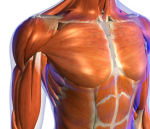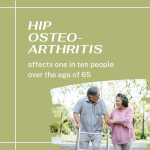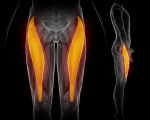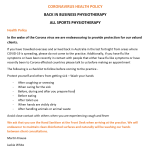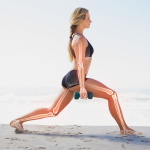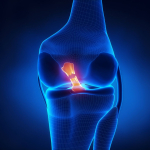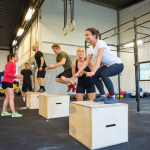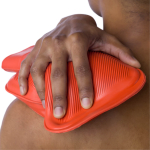Endurance, efficiency, biomechanics of plyometrics, and immune considerations (Martin Krause 2012)
Endurance = "time to fatigue"
Training - "you need to stress, not strain the system to create change"
This section of the website deals with immune, physiological and biomechanical considerations of rehabilitation and training. Specifically, avoidance of 'staleness' and immune compromise from over-training is dealt with in consideration with the biomechanics of concentric and eccentric muscle exercise. The aim is to gain an oversight on how to train to recover from injury or prevent further injury. Ideally, this section should be read along with the sections, found elsewhere on this website, dealing with exercise and the immune system, exercise and muscle mass (Sarcopenia) and nutritional aspects of musculoskeletal health.
Altered biomechanical conditions as a result of misuse, disuse, overuse, abuse results in damage which can cause a viscious reciprocating cycle of muscle-tendon atrophy, degenerative changes, and immune-metabolic dysfunction that creates an environment of morbidity from chronic musculoskeletal dysfunction. At Back in Business Physiotherapy we use a combination of 'hands-on' therapy, exercise and nutritional supplementation to optimise the rehabilitative process. Importantly, development of a base training level of fitness through endurance exercise is considered essential for the development and maintenance of musculoskeletal health. Several reasons exist for this hypothesis, one of which is the fact that the deeper slow twitch postural muscles are the stabilisers of the body and these are more effectively trained through slow endurance training. In contrast the multi-joint superficial muscles are the mobilisers - ballistic muscles of the body and are important for speed and agility but must be trained on a good endurance base. Once an endurance base has been achieved, the more functional and difficult exercises of eccentric, muscle lengthening and loading regimes of plyometrics can be used, by building a graduated, progressive and periodised training regime. Finally, allostatic mechanisms of training for stress management can be employed which are immune enhancing, so long as good training involves cognitive goal setting through mental and physiological considerations that result in the avoidance of injuries and the minimisation of lost training days through ill-health from 'over-reaching' and lack of periodisation of training to recover and improve on 'over-training'
Symptoms of 'over-reaching' or over training include mood disturbances ("three bastards in a day"), non-restorative sleep and heart rate variability demonstrating a slow response from rest to activity and rest again. Physiological markers include raised cortisol levels.
In 2020, the holy grail of confirming a presumptive myth was attained. Muscle memory is often talked about and assumed to be true. However, only recently have researchers examined this commonly held belief. 19 inactive healthy (male and female) subjects with a mean age of 25 years, were given a 16 week exercise program on one leg, followed by a 20 week detraining programme, followed by an acute bout of exercise. They found that both basal and exercise induced gene expression and self signalling, important to muscle adaptation to strength training can be altered with previous exposure to exercise. Interestingly, the genes examined showed both a sensitized and repressed response (Moberg et al 2020, Med Sc Sp Ex, 53, 8, 1679-1690). This is important when considering that the influence of exercise training, at a younger age, may have a significant lasting impact later in life, in older individuals, trying to prevent sarcopenia. It is also significant in training methodology and the use of periodisation in exercise prescription, where pre-conditoning occurs and can be used to attain more optimal results.
Index
Immunological factors as a result of disuse
A biphasic stress response has been described in muscles during 'reloading' after a period of 'unloading'. Mechanical unloading as a result of disuse results in substantial muscle atrophy. This atrophy is a result of both increased protein degradation and reduced protein synthesis. Signaling pathways leading to this, include oxidative stress, proinflammatory signaling, reduced stress response, including heat shock proteins (HSP) and insulin-like growth factor (IGF-1). Insufficient HSP and antioxidant enzymes elicits oxidative damage of proteins and lipids (Lawler et al 2003, Free Radic Biol Med, 35, 9-16). Hence, unloading elevates oxidative stress. Paradoxically, loading also elevates oxidative stress. Nuclear Factor kB (NF-kB) has been implicated in both processes. Unloading is thought to induce numerous pro-inflammatory genes including nitric oxide synthase, cytokines, ubiquitin pathway ligases as a result of withdrawal of the stress - response including HSP25, HSP70, IGF1/Akt pathway (Lawler et al 2006, Muscle Nerve, 33, 200-207). The early portion of reloading, after a period of immobilisation is characterised by muscle damage and inflammation which requires a cognitive approach using a realistic time-frame, of goal setting, for recovery to take place. Although, muscle recovery after 7-10 days of unloading is rapid (7 - 9 days), prolonged immobilisation greater than 17 days exhibits impaired recovery of muscle mass (Kasper 1995, J Appl Physiol, 79, 607-614). Reloading of muscles have been shown to result in a large up-regulation of NF-kB DNA-binding activity (Lawler et al 2012, Med Sci Sp Ex, 44, 4, 600-609). HSP25 phosphorylation decreased during prolonged unloading but returned to normal after 28 days of reloading. HSP70 and IGF-1 remained depressed during short term reloading but returned to normal levels as muscle mass improved, whereas in contrast Akt phosphorylation was greater in short term reloading but returned to normal by day 28 (Lawler et al 2012).
Immune considerations and nutritional supplementation
Investigations, into the immune system of endurance athletes, suggests that inflammation and immune sensitivity may be inversely proportional. For example, upper respiratory tract infections are common amongst runners. This may be due to irritation of the airways by air. Alternatively, it may be due to the irritation set up by the mechanical loading of the musculoskeletal system during training. Frequently, such mal-adaptations have been attributed to 'over-reaching', inadequate calorific intake and poor sleep hygiene or non-recuperative sleep. Periodisation of training allows the body to recuperate, it provides a learning experience for the athlete of what they can tolerate, how long it takes to recover and how to peak at the required time (see below). Many athletes are frightened to train less, when frequently less is more. How well an athlete recovers from exhaustive exercise not only determines athletic success but also frequently correlates with predisposition to injury and generalised poor health. By 2000, we were routinely taking salivary swabs of Swiss athletes in the year leading up to the Sydney Olympics. We often found a lack of salivary immunoglobulins in the period up to 2 hours after the cessation of training. However, in some instances, salivary immunoglobulins were already chronically low.

Researchers had already suggested the use of carbohydrate nutritional supplementation immediately after exercise. During my time, in Switzerland, leading up to the Barcelona Olympic Games, 1992, there was an emphasis placed on carbohydrate supplementation (multodextrene), as well as magnesium for tired muscles in addition to regular blood checks of ferratin levels for women. These days, the supermarket and gym shelves are full of nutritional supplements, including fish oils, anti-oxidants, Whey Protein and multi-vitamins. With such a wide variety of choices available, it would seem appropriate to seek a consultation with a sports nutritionist. Some information regarding carbohydrate supplementation can be found elsewhere on this website. Gut pro-biota have also been found to be important, such as Sauerkraut, for optimising the immune - energy axis to provide musculoskeletal work. This symbiotic relationship with energy demands, biomechanical demands and the immune system illustrates the balancing and competing nature of human physiology, a virtual oscillatory system, where perturbations vary depending on the energy inputs and the athletic outputs.
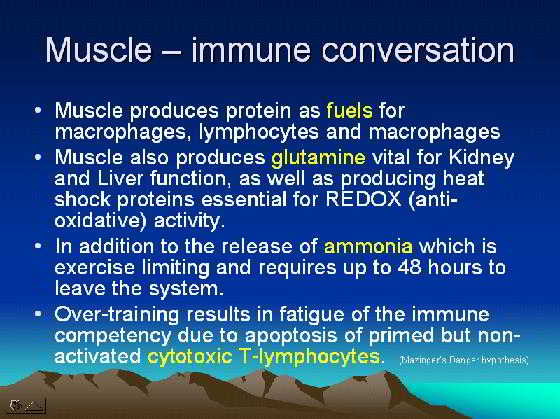
Traditionally, health was considered in terms of predictability. Consistent heart rate was considered good, irregular heart rate as bad. Unfortunately, it isn't quite so simple. In fact in terms of training concepts, low resting heart rate and how quickly the heart rate can oscillate with demand is used to diagnose if an athlete has become 'stale' or said in another way is in a state of 'over-training' or enhance physiological and/or psychological stress. Hence, in the light of these confounding 'beliefs', a more complex system (model) needs to be employed, involving random perturbations of an oscillatory system, if random 'outliers' are to be incorporated into our understanding of health.
Simplistic versions of sympathetic vs parasympathetic tone balancing the autonomic nervous system do not explain complexity. It is difficult to reconcile that the parasympathetic vagus nerve controls all thoracic and abdominal organ function and alone counters all 'chaos' of sympathetic nervous system activity, where the latter activity has a multitude of redundancy and interacts in multiple dimensions with an interlaced muscle-gut immune system complex. The sympathetic nervous system is the tight rope, the trapeze artist, the dancer, the orchestra, forged from the fire of genesis and the evolution of heat shock proteins. To understand the development of the muscle-gut immune system complex we must understand its uni-cellular componentry. Many athletes will complain of diarrhoea after, and even during, exhaustive exercise. Recovery and periodisation are critical to avoid loss of form and irritable bowel syndrome, but also potential life threatening health issues such as rhabdomyolysis.

Additionally, aging and vitality have been related to the capacity to enhance the immune system through exercise elsewhere on this website
Immune system and training
Author MACKINNON, LAUREL T
Institution School of Human Movement Studies, The University of Queensland, Brisbane, Queensland, Australia
Source Immunology & Cell Biology. 78(5):502-509, October 2000.
Abstract Summary:
Over-training is a process of excessive exercise training in high-performance athletes that may lead to over-training syndrome. Over-training syndrome is a neuroendocrine disorder characterized by poor performance in competition, inability to maintain training loads, persistent fatigue, reduced catecholamine excretion, frequent illness, disturbed sleep and alterations in mood state. Although high-performance athletes are generally not clinically immune deficient, there is evidence that several immune parameters are suppressed during prolonged periods of intense exercise training. These include decreases in neutrophil function, serum and salivary immunoglobulin concentrations and natural killer cell number and possibly cytotoxic activity in peripheral blood. Moreover, the incidence of symptoms of upper respiratory tract infection increases during periods of endurance training. However, all of these changes appear to result from prolonged periods of intense exercise training, rather than from the effects of over-training syndrome itself. At present, there is no single objective marker to identify over-training syndrome. It is best identified by a combination of markers, such as decreases in urinary norepinephrine output, maximal heart rate and blood lactate levels, impaired sport performance and work output at 110% of individual anaerobic threshold, and daily self-analysis by the athlete (e.g. high fatigue and stress ratings). The mechanisms underlying over-training syndrome have not been clearly identified, but are likely to involve autonomic dysfunction and possibly increased cytokine production resulting from the physical stress of intense daily training with inadequate recovery.
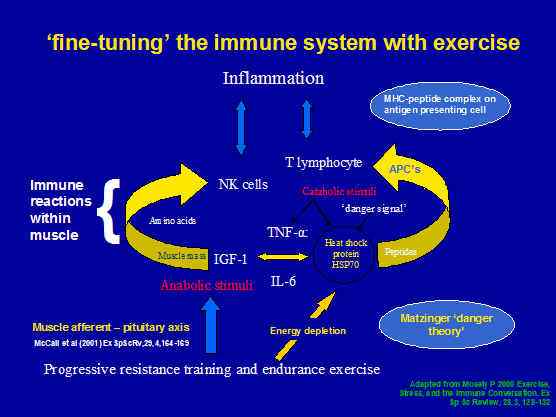 Exercise, Immune System, Cytokines, Heat Shock Proteins, Glutamine and muscle mass
Exercise, Immune System, Cytokines, Heat Shock Proteins, Glutamine and muscle mass
Oxidative stress after Ultra-endurance exercise (overuse)
Ultra-endurance events have been shown to be associated with prolonged depletion of anti-oxidant capacity up to one month post event (Turner et al 2011, Med Sc Ex Sp, 43, 9, 1770-1776). Specifically, glutathione (GSH) remained depleted to approximately 1/3 of pre-race values, for up to 28 days after the race.
Quality of movement, and hence performance breaks down as fatigue sets in.
Fatigue is the stressor which affects change, however excessive fatigue from one bout of exercise or from successive repeated bouts of exercise without adequate recovery can cause strain. A failure to plan is a plan waiting to fail.
Training - "you need to stress not strain the system to create performance enhancing change"
Overtraining
A common symptom of over-training is non-restorative sleep, immune compromise and stress fractures. Approximately, 1/3 of young athletes have experienced 'non functional over-reaching (NFOR) or over-training (OT) at least once in their sporting life (Matos et al 2011, Med Sc & Sp Ex, 43, 7, 1287-1294). The rate was higher in individual sports (37%) when compared with team sports (17%). Individual sporting endeavours tended to consume more than 2 hours per day, 6-7 days per week, which was significantly greater than the training volume reported in team sports. Females were more prevalent in the OT cohort (36% vs 26%). Moreover, even in low physical intensity sports such as golf individuals may suffer from NFOR/OT. Training load and volume alone wasn't the sole contributor to OT, as sporting individuals appeared to devote more time to their sport and less time to socialising and other school activities. Thus, they are at risk of developing a uni-dimensional personality which seems to place them at risk for NFOR/OT. Self esteem, identity and self-worth become intertwined which is fine whilst they are gaining sporting success, however sporting failure may result in stress and anxiety. Hence, young athletes should be encouraged to form multi-dimensional personalities through encouragement of a range of hobbies and interests.
Over training in female athletes can be particularly severe as O-T leads to alterations in the luteal phase of the menstrual cycle which results in dysmenohrea and potential reductions in bone mineral density and metabolic dysfunction due to reduced estrogen levels.
Alterations in Mood
The 3 B's Rule - if you meet one bastard in a day that is just unfortunate, if you meet 2 then it is very unfortunate, however if you meet three bastards in a day then you are in over-training!! It's you not them.
Musculoskeletal stress and the immune system
Recovery may involve analysis of technique, examination of training load (duration, frequency, intensity), adequate rest and nutrition, as well as a sound state of mind (mental strength). Over-training has been shown, within 4 weeks, after the onset of training, to be associated with increased oxidative stress both at rest and during submaximal exercise in a group of men after they underwent 7 weeks of intense military training (Tanskanen et al 2011, Med Sc Sp Ex, 43, 8, 1552-1560)
This principle applies equally to endurance athletes such as road cyclists and mountain bikers who need to avoid 'staleness' or stress from the monotomy or boredom in training and/or chronic fatigue from the high volume of training. In fact, when I was working with elite and professional cyclists in Europe, we commonly had road cyclists go running in the forest during the winter months to obtain greater strength and agility. Equally, we frequently asked skiers to mountain bike during the summer, or go hiking with very heavy backpacks up mountain sides. In one female downhill skier, she had been performing well early in the season, then began to perform poorly, to which she responded by training more. Our coaching team decided to send her to the beach for a holiday just weeks before the world championships. She became world champion!!! In some cases, reductions of stress consisted of cross training whereby road cyclists got on the track (in the former East Germany) and track cyclists got out on the road (Australian team in Mexico), as well as flat riders doing hills. Although specificity of training is of paramount importance, such cross training can reduce the risk of 'staleness' and excessive fatigue from doing too much of the same thing. Importantly, these strategies were most commonly employed during the off-season and/or in athletes who were still in their developmental phase of learning.
Cryostimulation
Whole body cryostimulation has been demonstrated to limit over-reaching in elite synchronized swimming, where variables such as reduced sleep quantity, increased fatigue and impaired exercise capacity are mitigated (Schaal K, et al 2015, Med Sc Sp Ex, 47, 7, 1416-1425). This is presumably as a result of heat shock proteins (Krause 2002) which are discussed elsewhere on this site.
Sleep
Sleep plays a critical role not only in recovery but also in the restoration of function of the immune system. Immune system can be discussed in terms of cellular (T helper cell Type I) and hormonal (T helper cell Type II) components. Each part has a counter-balancing regulating effect on the other. Th1 has an active role in fighting pathogens such as viruses and some bacteria (common in travelling teams and sports where open wounds can occur) as well as a role in fighting inflammation. Whereas, Th2 cells play a role in fighting against most bacteria as well as parasitic worms (Clow & Hucklebridge 2001 Ex Immun Review 7; 5-17, and Miyazaki et al 2005, Biol Psychol, 70, 1, 30-37). Cortisol, Prolactin, Melatonin and Growth Hormone have all been implicated in have a balancing affect on Th2 cells. During the early phases of sleep the immune system is pushed towards the Th1 profile which is associated with inflammatory processes. During the early phase (30-45minutes) of waking cortisol levels rise between 50 -150% creating a Th2 bias (Cutalo et al 2005, Autoimmunity Reviews 4, 8, 497-502) and hence a bias away from a pro-inflammatory profile. This may be why people may feel stiffer in the morning as a result of injury or over-training.
Sleeping at altitude can be beneficial but is also a 'stressor'. While normal air has 20.9% oxygen, when you do altitude training, you will be sleeping anywhere from 17% down to about 12% oxygen. In Switzerland, in the early 90's, we used a system of 'training high' and sleeping low, where we wanted the body to recover from altitude training. However, the reverse is frequently used, where 'altitude at night' is used to increase haemoglobin concentrations. These days, graded acclimatisation, using oxygen tents is used. The altitude training schedule builds over a month to a maximum altitude between 10,000 and 14,000 feet (3000 to 4300 meters).
Frequently, when a team or an athlete is underperforming the tendency is to train harder, more frequently and stress mentally about the underperformance. During my time as a physiotherapist to Swiss professional and elite athletes we demonstrated time and time again that good preparation, support and analysis of underperformance usually resulted in a quick return to optimum results. However, sometimes it was difficult to convince a Swiss National downhill skiing champion that she needed to spend a couple of weeks on the beach, just before their world championships!
At a competitive level, an endurance event is all about the conservation of energy, maximisation of efficiency, predictability, and maintaining some redundancy in the system for those unexpected moments in a race. Ultimately, it is about knowing yourself and learning to know your strengths and weaknesses as well as those of your competitors. The more multifactorial the training approach, the more experience which is gained and the greater the feedback for improvement. However, the immediate goals need to be attainable and be in synchrony with the long term goals (SMARTA - specific, measurable, achievable, relevant, timely, aligned).
Endurance training - "training the zones"
Zone One (<70% HR max): very low level light exercise, too low in itself to induce physiological adaptations. Minimal sensation of effort or fatigue. Easy to hold a conversation. Used as a recovery strategy between bouts of exercise (intervals) or as a recovery strategy after a hard training session or long race.
Zone Two: (endurance 71-80% HR max): classic long slow all day long distance training. Good for gaining and endurance base. However, if too much time is spent training slow, you become slow. Recovery from 2 hour sessions should be quite rapid, whereas longer sessions with some moderately fatiguing climbs may take 1-2 days to recover
Zone Three (tempo 81-85% HR max): intensity as a result of speed. Frequent sensation of fatigue, concentration required, conversation becoming difficult. Daily sessions possible so long as adequate energy requirements are met. HR recovery may be a good test to indicate how well you have recovered.
Zone Four (lactic threshold 86-94% HR max): efforts similar to time trialing on a bike. Continuous conversation very difficult. Continuous sensation of effort or fatigue in muscles being exercised. Mentally very taxing and generally performed in blocks or repeats of exercise with some recovery between bouts but not too long e.g. running 1-3 minute blocks with 1-3 minute rest in between; cycling 10-30 minutes with 10-30 minute recovery between blocks of exercise. Consecutive days of training possible, but check HR recovery every morning and also maintain an immune enhancing diet. Not wise to do just before a big race. Also unwise to do if there is a lot of other stress in your life. Recovery is super important.
Zone Five (95-120% HR max): short intense bouts of activity. Running 10-30 seconds, Cycling 3-8 minutes. Strong to severe sensation of fatigue. Laboured breathing. Repeated consecutive days of training not recommended and considered undesirable.
Endurance training - periodization
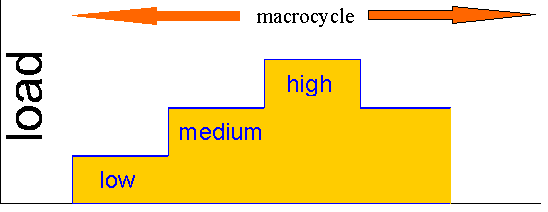
Periodisation of training allows the athlete to gradually build up their training volume and/or intensity, whilst allowing time for regeneration. Gradual increments of loading can occur, whilst reducing the risk of excessive over-loading and hence injury. Additionally, training of various intensities allows the metabolic systems to develop in parallel. Thereby the anaerobic and aerobic metabolic systems can be used to drive endurance.

Power
The development of endurance may take months and up to 10 years. Strength is required to develop power, as power is equal to the product of force times velocity. Power is important for speed. Frequently, endurance athletes train slow and stay slow. They also need power which in German is called "Steigungsvermoegen".
Maximising strength also enables the body to enhance the firing of impulses to the muscles by the central nervous systems.

Since power = force x velocity then strength training to attain power requires velocity. However, an inverse relationship exists between force and velocity. As velocity increases, the force of contraction decreases. Soft sand running or running in knee deep water may be a good compromise in the quest to attain power. Additionally, these forms of training help reduce over-striding and high impacts of foot strike as speed increases.

In this example from cycling research, performance power can improve by 22% through improved technique of hip extension. Biomechanics can influence the immuno-physiology and vice versa.

Bio-motor abilities specific to running ability may be attained using for examples eccentric (muscle lengthening) quadriceps, calf and hip muscle loading in lunging.
Muscle biomechanics

Understanding muscle biomechanics and length-tension relationships (Hill model) allows for more specific training stimuli. Ultimately, the optimisation of power requires a balance between velocity and force since P=Fv. Similarly, efficiency may be improved by considering Power as Work over time P=W/t
Plyometric biomechanics
Plyometric exercises designed to improve power use the concepts of elastic and kinetic potential energy to improve energy absorption and movement execution. The following equations are taken from Wikipedia (7May2008)

This allows better utilisation of the stretch-shortening cycle of the lower limb muscles, in addition to reducing excessive muscle hypertrophy.
Plyometrics and eccentric muscle adaptations (Martin Krause 2003)
The eccentric component to this exercise cause more profound changes to the connective tissue of the muscle (broadening and streaming of Z bands) than concentric exercise. Investigations into eccentric exercise revealed pain 8 hours after initial exercise which was maximal 48 hours later (DOMS = delayed onset muscle soreness) (Newham, Mills, Quigley, Edwards 1983). These investigators found low frequency fatigue 10 minutes after a 20 minute period of stepping (Newham et al 1983). Additionally, they demonstrated progressive increases in IEMG during the exercise in the rectus femoris (160% increase) and vastus medialis (140% increase) in the eccentric contracting leg (Newham et al 1983). Mechanical damage to the sarcoplasmic reticulum resulting in less calcium release for each excitatory action potential was suggested as the cause of the low frequency fatigue (Newham et al 1983).

However, a number of sites in the myofibrillar complex such as reduce binding sensitivity and capacity of Troponin C for calcium, altered troponin-tropomysosin interaction to impaired binding and force generation by actin and myosin have been implicated in impaired force generation (Green 1990). Indeed, in the absence of any association between relaxation rates and Calcium kinetics raises support for the notion of a rate-limiting process controlling the relaxation of fatigued muscles being located in the contractile proteins (Hill et al 2001). During fatigue the relaxation times can be prolonged as much as 50% (Bigland-Ritchie et al 1986) thus resulting in increased force generation during submaximal stimulation due to tetanic fusion despite a substantial fall in the maximum tetanic force (Bigland-Ritchie et al 1986).
The initial overall loss of force production seen may be due to Desmin and Titan damage (Lieber & Friden 2002). Desmin acts as an extra-sarcomeric mechanical stabilizer between adjacent Z discs and the attachment to the costomere at the sarcolemma (Lieber, Shah & Fridén 2002). The costomere complex contains Talin, Vinculin & Dystrophin which attach to the trans-sarcolemmal proteins Integrin and Dystrophin associated proteins. These proteins allow the lateral transmission of force from actin to the basal lamina containing type IV collagen which is contiguous with the endomysium (Kovanen 2002). Desmin loss after eccentric exercise can occur within 5 minutes, possibly as a result of increased intracellular Calcium leading to Calpain activation and selective hydrolysis of intermediate filament network (Lieber & Fridén 2002). This may result in the ‘popping of sarcomeres' of different length thereby potentially loosing their myofilament overlap of actin and myosin (Lieber & Fridén 2002). Hence, reduced force production would be expected. Additionally, the release of matrix metalloproteinase (MMP) which may degrade the extramyocellular type IV collagen (Korskinen, Kovanen, Komulainen et al 1996). However, this effect occurs many days after exercise (Korskinen et al 1996) and could even effect torque production 28 days after exercise (Lieber & Fridén 2002). This has significant implications in exercise training prescription.
flash file created by Martin Krause 2003
Titan molecules span the gap between the ends of the thick filaments and Z-bands. At the 2007 MPA conference in Cairns, Rob Herbert, provided the AJP oration whereby he explained the significance of Titan as a major determinant of extensibility in muscle fibres. Additionally, he stated that Titan is differentially expressed in human skeletal muscle as short stiff fibres and long compliant fibres
Costomeres are 15 different proteins
- Low oxidative muscles have a tendency to tear during eccentric exercise
- Loss of desmin proceeds loss of fibronectin membrane
- Fibre strain results in increased intracellular and extracellular calcium which ?may lead to desmin hydrolysis through calpaine?
- Sarcomere shortening occurs to the detriment of tendon lengthening
- Excitation-contractile coupling may be the area disrupted rather than pure sarcomere disruption
- Structural changes of the disruption of the cytoskeleton include dystrophin (sublaminal membrane protein), sometimes desmin and titin, whereas alpha actin is always OK ?suggesting that calpaine is not the enzyme responsible for protein dysruption?
- Creatine Kinase has no correlation with these cytoskeletal changes
- Inflammatory process important for tissue cleaning and remodelling
- Mechanism for muscle adaptation may be myosin gene regulation - heavy chain myosin isoform upregulation
- Oxygen into the Mitochondria and through the electron transfer chain (ETC) results in ATP use of 20% for power and 80% for heat, therefore people producing less heat may be producing more power?
- Slow twitch muscle fibre concentration varies with the years of training
- Cycling cadence velocity at peak efficiency for slow twitch muscle fibres is 80rpm
Vibration fatigue is probably reduced through enhanced transverse forces by wearing pressure garments such as SKINS. Additionally, venous return is probably also improved through the pressure gradient which these garments provide.
Also check out the 'tensegrity model' as it applies to microbiomechanical and macrobiomechanical structure, flexibility and integrity - the new way of the future
Inverse Dynamics
Inverse dynamics dictates that in an accelerating system, the forces are directed along the muscles which span more than one joint to provide a mechanism for the transfer of energy from one limb segment to the next. Clinically, this has important implications in training, as the entire limb must be functioning optimally to be able to attain efficiency of movement.


Muscle control
Peripheral muscle contractile efficiency may be enhanced if the muscles origin at the pelvis is stabilised by core stability muscles such as transverse abdominis, pelvic floor, diaphragm and internal oblique. Certain one joint muscles such as, for example, the obturator internus are biomechanically continuous with the pelvic floor and hence provide an important stabilising function as well as act as a conduit for the obturator nerve. The iliacus stabilises the hip whilst the Psoas membrane is continuous with the diaphragm and hence has an important lumbo-pelvic-costal stabilising function as well as acting as a hip flexor. Moreover, the 2 joint muscles acting as 'energy straps' between body segments eg knee - pelvis will require stabilising actions in the trunk based on Newtons third law of action-reaction. Importantly, these forces only occur in the same plane of motion. Therefore, muscles which act in multiple planes of motion are inherently better stabilisers of multidimensional joint motion than muscle which act solely in single planes of motion. Naturally, in a functionally unstable spine, it would be better that the reaction force is anticipated by the appropriate bracing beforehand. This would require 'feedforward' motor control of movement. Additionally lack of pelvic control would result in reduced lumbopelvic rhythm making leg movements not only inefficient but also potentially injury producing through 'misuse'. Therefore, the hamstring, quadriceps, gluteal, ITB-Tfl muscles would need to act synergistically with the trunk muscles. Regardless of how strong the core muscles are, 'the tail ends up wagging the dog' if the correct co-ordination and timing between muscle groups isn't present. Similarly, based on the 'energy strap' hypothesis even calf muscle tightness can produce increased anterior tilting and rotation of the pelvis making a person appear to be walking with their 'tail wagging in the air'. It is therefore important to provide verbal and visual feedback to the person so that they become cognisant with reasons for their ongoing problems of pain and/or reduced sporting performance.
Gym workouts using large muscle mass usually requires 48-72 hours rest between bouts of training. However, large amounts of concentric exercise with emphasis on 1 rep max will result in adverse weight to power ratios due to excessive hypertrophy of the muscle group. Therefore, when considering endurance type of sporting activity, 3 sets of 7-15 repetitions may be more beneficial, especially when eccentric contractions are used.
Motor control and oscillatory systems
Motor learning theory devised by Bernstein suggests that the body will use the momentum of the limbs to optimize the degrees of freedom in the system. Similar to a mass-spring analogy where the perturbations of the mass will be dependent on the damping characteristics of the spring, the brain will introduce muscle tone to dampen the angular velocity and hence acceleration of the system. Therefore, instead of the muscles of the leg lifting the limb, the antagonistic muscles are decelerating the limb towards the end of trajectory. Moreover, by using eccentric (muscle lengthening and contracting) muscle contractions the system becomes efficient through these decelerating movements through enhanced visco-elastic rebound as well as the conservation of momentum.


Changing speed of training, not only allows the use of various metabolic energy systems, but it also trains mechanical efficiency and therefore should reduce the rate of energy expenditure. The more efficient the system the greater the time to fatigue may be. Importantly, acceleration places an emphases on the changing velocity. Sprint training, Fartlek training (progressive increases and decreases in speed), counter jumps (plyometrics), eccentric-concentric leg pressing, eccentric-concentric lunging, undulating hills, running-jumping are all exercises which may improve angular momentum and therefore efficiency.
Besides training implications, there are also clinical considerations when for example a component of the kinetic chain isn't functioning in it's stretch-shortening cycle and energy dissipation function as it is supposed.
Hip-back stability exercises


Stair and hill work should further tune the bio-motor abilities. Core stability exercises for the abdominal region using a Swiss Ball or Body Blade may be another example of specific strength training, which should enhance efficiency through improved lumbo-pelvic rhythm. Poor technique can lead to inefficiency and injury (eg hip-low back pain).



Back and diaphragmatic dynamic stability

Improved thoracic function through lateral diaphragmatic breathing for enhanced blood flow, improved eccentric iliopsoas and superficial abdominal oblique muscles efficiency, as well as enhanced scapula positioning and improved pelvic floor function.
Heart rate variability
More precise monitoring of the rate of recovery can be achieved by examining 'Heart Rate Variability'whereby the response of the heart from 3 minutes prone to 2 minutes of upright posture is measured. High variability dictates a fresh response - low variability indicates a 'stale response' or high stress related fatigue. This allows the athlete to more objectively determine which days should be recovery days and which ones are days where they can train a little harder. Importantly, chronically reduced HRV is suggested to be a 'red flag' for sudden cardiac arrest in otherwise fit and healthy individuals. Such individuals should have further testing by a cardiologist before recommencing their training regime.
Training phases

Training phases may be separated into various stages depending upon the age of the athlete and whether the athlete is a novice or an experienced athlete. General physical abilities may include multilateral development of endurance eg using cycling and swimming or even a team sport like soccer as an adjunct to running training. Specific physical suggests more time devoted to the particular run eg 5000m vs 10000m vs marathon vs orienteering and less time devoted to other sports.
However, during the regeneration phase of periodisation or during an injury the other sporting abilities may play a greater role.
Specific bio-motor abilities relates to those aspects of the sport which relate to specific training regimes to enhance co-ordination, strength and agility. Plyometrics using depth jumps and rebound is an example of such a specific training regime and should only be used in the already well trained athlete. Sports such as Orienteering require endurance, power and agility in terrain and therefore utilises speed work on various ground, in various vegetation and on different slopes.

Don't increase your training volume by more than 10% in a week
Remember the 3B's (Bastards in a day) Rule
Competitive phase
As training proceeds into the competitive phase some athletes place a higher proportion of their loading on intensity whilst reducing the total volume of training. Cycles such as this one may be biannual or biennial. Importantly, periodisation and cyclic loading is not restricted to any particular time frame. Although, it does place emphasis on incremental loading moreover it places emphasis on optimal regeneration and recovery. Additionally, such a methodology provides a 'base' for the next cycle of training activities. Each macrocycle may be made up from micro cycles which can last days, weeks, months or years. Remember, each time you train to change your bodies abilities you are stressing the system and therefore recuperation is important.
Cooling muscles
Cooling muscles will also profoundly affect the rate of contractile responses to neural input. Through cooling, the muscles resting tension increases.

Good Reading
Conclusion
Altered biomechanical conditions as a result of misuse, disuse, overuse, abuse results in damage which can cause a vicious reciprocating cycle of muscle-tendon atrophy, degenerative changes, and immune-metabolic dysfunction that creates an environment of morbidity from ensuing chronic musculoskeletal dysfunction. Allostatic mechanisms of training for stress management can be employed which are immune enhancing, so long as good training techniques, involve cognitive goal setting, through mental and physiological considerations, that result in the avoidance of injuries and the minimisation of lost training days through ill-health. Periodisation of training and correct technique reduce the risk of over-training, 'staleness', immune compromise and injury by considering the importance of rest, nutrition and correct biomechanical and physiological loading. Please look at Link to Training and Rehabilitation for further details
REFERENCES:
Bigland-Ritchie B, Bellemare F, Woods JJ (1986) Excitation frequencies and sites of fatigue. In : Jones NL, McCartney N, McComas AJ (Eds) Human Muscle Power . Human Kinetics Publisher, Champaign Ill , pp197-213.
Green HJ (1990) Manifestations and sites of neuromuscular fatigue. In: Taylor AW, Green HJ, Ianuzzo D, Sutton J (Eds). Biochemistry of Exercise Human Kinetics Publisher, Champaign, Ill., pp 13-25
Hill CA, Thompson MW, Ruell PA, Thom JM, White MJ (2001). Sarcoplasmic reticulum function and muscle contractile character following fatiguing exercise in humans. Journal of Physiology , 531.3 , 871-878.
Koskinen S, Kovanen V, Komulainen J, Hesselink H, Kuipers H, Vihko V, Takala T (1996). Type IV collagen, MMP-2, and TIMP-2 mRNA levels in skeletal muscle subjected to forced eccentric contractions. Medicine & Science in Sports & Exercise , 28 , 153
Kovanen V (2002). Intramuscular Extracellular matrix: complex environment of muscle cells. Exercise Sports Science Reviews , 30 , 20-25
Krishnathasan D, Vandervoort, AA (2000). Eccentric strength training prescription in older adults. Topics in Geriatric Rehabilitation , 15 , 3, 29-40.
Lieber RL, Fridén J (2002). Mechanisms of muscle injury gleaned from animal models. American Journal of Physical Medicine and Rehabilitation , 81 , 11, S70-S79
Lieber RL, Shah S, Fridén J (2002). Cytoskeletal disruption after eccentric contraction-induced muscle injury. Clinical orthopaedics and related research , 403S , S90-S99.
Newham DJ, Mills KR, Quigley BM, Edwards RHT (1983). Pain and fatigue after concentric and eccentric muscle contractions. Clinical Science , 64 , 55-62
Sun Tzu : The Art of War
mastery of energy, mastery of the heart, mastery of strength, and mastery of adaptation
they who know themselves and know their adversary will always win
Last update : 12 July 2021






 Exercise and fine-tuning the immune system through the development of sympathetic nervous system control over allostasis - implications for over-training, stress, pain management and cognitive behavioural therapy
Exercise and fine-tuning the immune system through the development of sympathetic nervous system control over allostasis - implications for over-training, stress, pain management and cognitive behavioural therapy


















